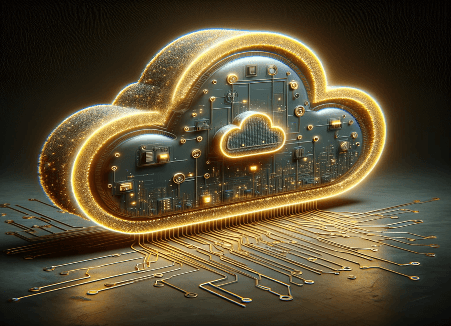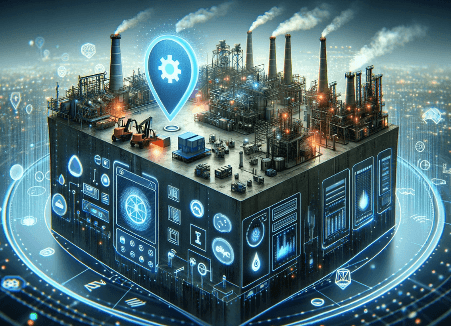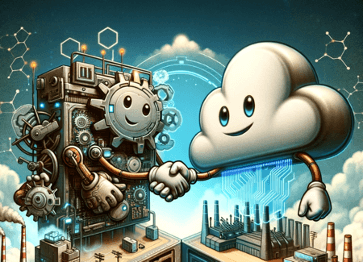Dave McMorran
Director of Sales Engineering
Wondering whether the legacy systems of record can be augmented to meet the demands of tomorrow’s goals?
Edge computing moves computing power closer to data sources. It has 3 aspects: consumer, enterprise, and industrial IoT edge. An industrial edge DataOps platform provides real-time insights, analytics, and remote monitoring for industrial settings.

To many in the tech sector, the word ‘edge’ is little more than just a buzzword. The latest in a long list of jargon used to describe the various aspects of an industry that is as vital as it is seemingly impenetrable.
For us, however, the edge is central to what we do, and we don’t throw this term around lightly.
Consulting a dictionary for the word’s meaning reveals multiple definitions, none of which accurately describe what we do. For example, an edge can refer to a blade’s sharpened side or a quality that provides superiority over close rivals. A third definition is “the outside limit of an object, area or surface.”
With so many definitions, the time is right to help expand horizons and unpack the meaning of Edge.
Also known as edge computing, the edge involves moving computing power closer to the source of data, typically Internet of Things (IoT) devices or sensors.
The term, however, is quite broad and applies to a range of contexts and environments, each with its own distinct characteristics and uses. Often, it’s loosely defined as ‘anything not in the cloud or a central data center,’ a description borne out of frustration with its vague nature.
To gain a clearer understanding, some delve into more specific classifications, leading to concepts like the ‘far edge,’ encompassing mobile devices and smart sensors, and the ‘near edge,’ which includes micro-data centers and remote office computing.
Yet, these categories only begin to uncover the many layers of edge computing. It’s a concept with numerous facets, impacting various aspects of life profoundly. Therefore, the most committed, and we count ourselves among that number, strive to distinguish and define these different aspects of edge computing more precisely.
Specifically, there are three major aspects of edge computing:
Consumer edge – We interact with the consumer edge in our everyday lives. The “consumer edge” covers everyday devices. That includes tablets, smart home gadgets, wearables, and other personal technology.
Enterprise edge – This refers to edge computing within a corporate or enterprise setting. It has evolved significantly over the years. At first, it started out as an extension of the main enterprise data center, involving the use of local servers, routers, and switches within a business setting.
Today, however, the enterprise edge includes various elements like data centers in remote office locations, smaller-scale micro-data centers, or server racks in compact server rooms. These are typically managed by IT teams, much like the traditional, centralized data centers around us.
Industrial IoT edge – The Industrial IoT (IIoT) edge refers to edge computing in industrial environments, such as manufacturing plants, oil rigs, warehouses, etc. It is the edge we focus on here at Litmus and it is otherwise known as the “industrial edge.” Let’s dig a little deeper.
The industrial IoT edge focuses on processing data generated by the equipment, sensors, and machines you would find there.
Just like the other edges described above, it is a decentralized approach where computing happens close to the data generation points but in an industrial setting.
Three indispensable benefits include:
Real-time Data Processing: Essential for monitoring and controlling industrial processes where immediate response is crucial.
Operational Efficiency: Helps optimize manufacturing processes, predictive maintenance, and minimize downtime.
Integration with Industrial Systems: Often involves integration with legacy systems and protocols specific to industrial environments.
But how did we get to where we are today? Well, the concept of the IIoT edge goes back several decades. The invention of the PLC in the late 1960s was a pivotal moment – and the minicomputers from DEC also played a key early role. That set the stage for the PC explosion in the early 1980s, which changed everything.
Since then, developments including data historians, the OPC DA/HDA, the Opto22 “brain board,” RTUs, token ring networks, and SAP MII, among others, all played crucial roles in the IIoT edge emerging around us.
With all this data now available, there is a pressing need to capture it fully, contextualize it properly, and embed it in our decision-making processes.

To harness the full potential of edge computing, an industrial edge DataOps platform is indispensable. It’s crucial for organizations aiming to enhance their operational visibility and control. Not only does it facilitate advanced analytics and support remote monitoring and maintenance, but it also incorporates modern deployment methods and offers great flexibility and integration across various vendor technologies. A unifying Industrial DataOps platform stands out and far exceeds what multiple siloed, sub-optimal systems joined together with custom development can deliver – with respect to ease of use, scale, and security.
Let’s delve into the specific advantages of using one:
Improved Data and Machine Visibility: Organizations need to understand the current state of their equipment and assets. An edge data platform provides real-time insights into critical performance indicators like uptime, downtime, throughput, and Overall Equipment Effectiveness (OEE). This visibility is essential for benchmarking and identifying underperforming facilities.
Operational Monitoring and Advanced Analytics: An edge data platform enables condition monitoring and operational visibility. It allows organizations to progress towards more sophisticated applications like predictive analytics. This includes predictive maintenance and quality use cases, which are crucial for proactive management and minimizing downtime.
Remote Operations: With edge computing, organizations can remotely monitor, configure, and maintain assets. This capability is particularly valuable for managing widespread or inaccessible locations, improving operational efficiency, and reducing the need for on-site interventions.
Flexibility and Openness: The platform should be open and flexible, avoiding vendor lock-in scenarios. A non-restrictive, vendor-neutral edge platform allows organizations to integrate with a heterogeneous environment, leveraging various solutions and applications. This openness is key to harnessing the full potential of edge computing, offering access to a wide array of data uses and integrations.
Utilization of Modern Deployment Mechanisms: Adopting modern deployment techniques like Kubernetes and containerized applications at the edge is crucial. These technologies offer better management, scalability, and security than traditional methods. They also reduce the risks associated with unmanaged and outdated systems.
Want to see a platform for Industrial Data Ops firsthand? Here’s a link to our demo. Let us know your thoughts.
For all the advantages of edge computing, it remains just one element of a comprehensive IIoT strategy. More tailored than a horizontal cloud solution, industrial data clouds are a vital counterpart to IIoT edge environments and play a pivotal role in realizing value for industrial operators. Distinguished from the decentralized nature of edge environments, the industrial data cloud represents a centralized framework that can be paired with edge environments to extend data accessibility.
Industrial data clouds are vertical-specific cloud solutions built to overcome the shortcomings of horizontal cloud environments. Working seamlessly with industrial edge environments to handle the complexity of industrial data (volume, variety, velocity), these cloud environments are tailored specifically to the needs of industrial organizations. According to Forrester:
Modern industry clouds deliver industry-specific experiences that connect processes and data from the front and back office. They comprise industry-specific components plus add-ons that deliver last-mile capabilities…
Simply, horizontal cloud solutions are too generic to meet the unique needs of industrial operations without heavy customization. Industrial data clouds align with industrial workflows, packaging cloud services into industrial-specific offerings and include seamless integration into industrial IoT edge environments. This allows organizations to manage industrial data close to the source while providing full control over what data should reside in the cloud for industrial solutions. The combination of industrial edge environments with industrial data clouds, like the one offered by Cognite, provides the complete edge-to-cloud solution for Industrial DataOps.
By extending Industrial DataOps to the cloud, industrial organizations can increase the scope of operational use cases that can be addressed by incorporating the breadth of IT and engineering data sources that also exist in IT and engineering domain silos. Industrial DataOps in the cloud must combine the data unification provided at the edge (as discussed above) while also extending the breadth of data types that can be unified. Combining a golden edge with an industrial data cloud unlocks the potential of edge-to-cloud Industrial DataOps. It provides simple access to complex industrial data required to build and scale operational insights rapidly.
Advantages of using industrial data clouds like Cognite Data Fusion to support Industrial DataOps initiatives include:
Universal access to industrial data: Connect to IIoT Edge environment, historians, MES, engineering documents, drawings, 3D models, unstructured images, video and audio, ERP, and CMMS systems. Fast integration with an industrial-specific, pre-built extractor catalog — across all industrial enterprise source systems.
Making Generative AI Work for Industry: deterministic, hallucination-free, data-leakage-free, real-time data inclusive Generative AI solutions that cover ET/OT/IT industrial data, including the ability to instantly search all industrial data, including data locked inside long engineering and operational documents.
AI-Powered Data Contextualization: Industrial-data-specific data contextualization pipeline services that generate relationships between data entities from different ET/OT/IT data sets. These AI-powered data contextualization services create and maintain an up-to-date Industrial Knowledge Graph — which itself is mandatory to both make Generative AI work for industry (see above) as well as to deliver real-time immersive digital twin solutions to users.
High-performance Industrial Knowledge Graph built on flexible data modeling: The ability to model all industrial data types flexibly to represent and express industrial reality in domain data models and solution data models in a unified data modeling service with well-documented, open, high-performance, low-latency APIs. This Industrial Knowledge Graph is the digital representation of operations necessary for digital twins, trustworthy Generative AI solutions, and to rapidly develop and scale solutions to production
No lock-in, Fully Open, Infinitely Extensible, Secure: Built API-first, allowing you to access everything programmatically, connect to any other system, and extend effortlessly in any direction you choose. Choose from best-of-breed options and fully leverage your incumbent technology stack with the control you need to protect your IP.
System of Engagement built for operational and engineering SMEs: Purpose-built for ET/OT/IT data collaborative workspace that is a unique system of engagement for e.g., troubleshooting and root-cause analysis with live ET/OT/IT data, allowing operational and engineering subject matter experts to work with real-time data on common problem solving 10x more efficiently than with anything else.

Recognizing the unique capabilities of each, it becomes clear that an integrated approach, which combines the cloud’s robust centralized processing with the edge’s efficient local data management, is not just beneficial but necessary for a robust and scalable IIoT strategy.
That’s why we thought it would be helpful to list our top 7 reasons why industries must embrace this synergy, effectively giving their cloud strategies a dynamic, ‘golden edge’.
Enhanced Response Times at the Edge
Edge computing enables immediate local data processing, which is crucial for time-sensitive operations in environments like factories, reducing latency and enhancing response times.
Efficient Bandwidth Usage
Processing data at the edge means only essential information is sent to the cloud, conserving bandwidth and reducing network strain by filtering out unnecessary data transmissions.
Comprehensive Hybrid Model
The hybrid approach merges the edge’s rapid decision-making with the cloud’s expansive storage and advanced analytics capabilities, offering a balanced, effective IIoT strategy.
Architectural Adaptability
A combined edge-cloud architecture accommodates varying enterprise requirements, including scalability and security, by enabling dynamic workload distribution and system compatibility.
Operational Independence at the Edge
Edge computing provides operational autonomy, crucial for remote or isolated environments, ensuring continuous operation even with intermittent cloud connectivity.
Robust Security and Data Integrity
By processing sensitive data locally at the edge, exposure is minimized, while the cloud adds layers of security and backup options, ensuring overall system reliability and data protection.
Cost-Effective Data Management
Integrating edge computing allows for initial data processing and analysis, reducing the load on cloud resources. This approach ensures that only valuable, processed data is sent to the cloud, optimizing costs and resource utilization.
Our customers are collecting 10,000 PLC tags, one every second, but they’re not sending everything to Cloud. Instead, they use the edge to calculate averages and correlations, creating arrays. Then, once that’s done, they are integrating 100 or so of those points into the Cloud, and that’s what matters. This architecture is 100% right. That’s exactly how it’s supposed to be. – Vatsal Shah, Litmus CEO
The integration of both the edge and the cloud is not just beneficial but essential for modern industrial operations. The edge offers immediate, local processing capabilities, crucial in fast-paced industrial environments, while the cloud provides the computational power and storage capacity needed for more intensive tasks.
The edge and cloud are symbiotic. By leveraging both strengths, organizations can achieve a more efficient, secure, and scalable IIoT infrastructure.
As you contemplate the future of your organization’s IIoT strategy, consider the immense potential of a combined edge and cloud approach. The efficiency, scalability, and adaptability it brings can propel your operations to new heights.
So, why not start with Litmus Edge for your edge computing needs and then dive deeper into Cognite Data Fusion? Experience firsthand how this blend can ignite your DataOps and drive your business towards an integrated, efficient, and innovative future.
Suranjeeta Choudhury
Director Product Marketing and Industry Relations
Suranjeeta Choudhury heads Product Marketing and Analysts Relations at Litmus.
Dave McMorran
Director of Sales Engineering
Wondering whether the legacy systems of record can be augmented to meet the demands of tomorrow’s goals?
Dave McMorran
Director of Sales Engineering
In manufacturing, embracing digital transformation is crucial. Litmus Edge simplifies the Unified Namespace (UNS) architecture, making it seamless to transition to digital and thrive in the modern landscape.
Suranjeeta Choudhury
Director Product Marketing and Industry Relations
Earlier this week, we announced the launch of Private Beta of Litmus MQTT – the world’s first ever enterprise-grade MQTT broker that’s actually built for Industrial IoT. The Private Beta version is now open for early access sign-up.